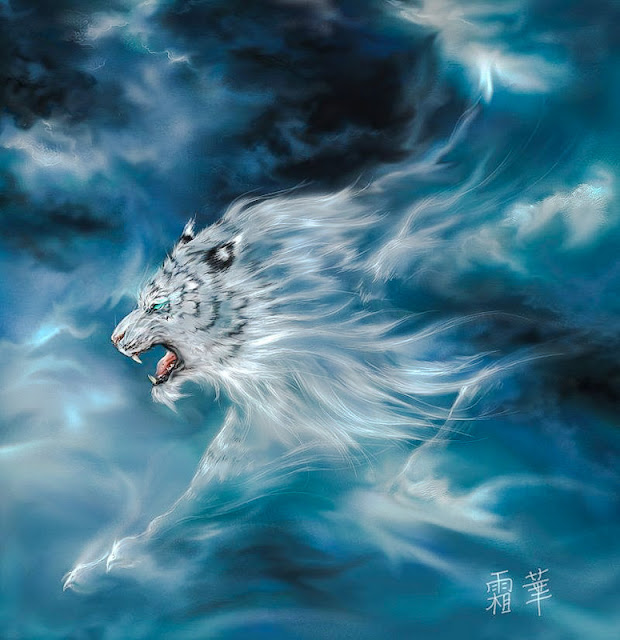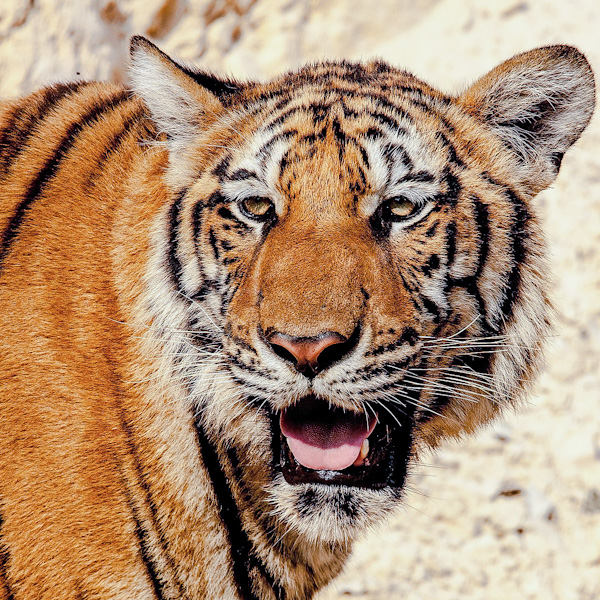South China Tiger
I have said that the South China tiger subspecies (Panthera tigris amoyensis) is totally extinct - captive or wild. That may be a rash statement but it is based on sensible thought and real information.
As at 2002, on the publication of the Sunquist's renown Wild Cats Of The World, of the five-remaining subspecies of the tiger (I say it's four now) the South China tiger was the most endangered.
The decline in population was rapid at the end. In 1949 it was thought that there were 4,000 individuals. However, this fantastic animal was "declared a pest" and mercilessly persecuted. I can understand one aspect of this. The tiger is hard to live with because it is a very large and a potentially dangerous animal. Humankind has great difficulty sharing the planet with it. But the main reason for its decline is Chinese medicine.
Please note that I am not being judgemental. I am simply describing what has gone on.
By 1980, 3,000 skins had been collected, apparently. The numbers are staggering. 3,000 extra tigers today would be priceless for conservationists. By 1977 only 100 were left. At 2002 it was thought that about 30-50 South China tigers remained in the wild with 32 in zoos in China. As at 1991 a survey established that they still existed in the wild in scattered locations at northern Guangdong, in Hunan and the western Fujian Provinces. Reports also indicated that the tiger existed in central Jiangxi.
Persecution as a pest was catastrophic but habitat loss has played a significant part. The habitat was "fragmented and exploited". I say "was" because it is today considered extinct in the wild but it takes time for this to be confirmed.
Tigers living in small fragmented ranges of less than 50,000 hectares (193 square miles) were in competition with humans for prey and sometimes trapped in traps set for prey. The South China tiger was still hunted right to the end especially for bones and body parts. Tiger body parts especially tiger bone is very important in the preparation of traditional Chinese medicine.
Tiger bone has been used in traditional Chinese medicine for 1000 years and is possibly the single most important factor in the decline in all tigers in Asia.
Powdered tiger bone is used for:
Twenty-five traditional Chinese medicines contain tiger bone. In 1985 there were 110 pharmaceutical factories producing tiger bone products. It makes you think. When the tiger become extinct, they'll have to find something else to use. Of course, there are many tiger farms in China and about 5,000 captive tigers, but I am sure wild tiger bone is considered much better for medicinal purposes. Incidentally a small tiger has 7 kg of bone.
I guess I have made my point. As I said this is not judgmental, just very sad for people concerned about the remaining tigers in the wild that are still poached for tiger body parts. The Bengal tiger is the nearest geographically to the Chinese marketplace and is therefore suffering as a result. The Bengal tiger is under serious threat of becoming extinct in the wild. The Siberian tiger population although much smaller is more stable.
You can read more on the subject of tiger bone if you wish.
Reference: Wild Cats Of The World page 362 - ISBN-13: 978-0-226-77999-7
As at 2002, on the publication of the Sunquist's renown Wild Cats Of The World, of the five-remaining subspecies of the tiger (I say it's four now) the South China tiger was the most endangered.
| Tiger farm - Photo by International Tiger Coalition |
The decline in population was rapid at the end. In 1949 it was thought that there were 4,000 individuals. However, this fantastic animal was "declared a pest" and mercilessly persecuted. I can understand one aspect of this. The tiger is hard to live with because it is a very large and a potentially dangerous animal. Humankind has great difficulty sharing the planet with it. But the main reason for its decline is Chinese medicine.
Please note that I am not being judgemental. I am simply describing what has gone on.
By 1980, 3,000 skins had been collected, apparently. The numbers are staggering. 3,000 extra tigers today would be priceless for conservationists. By 1977 only 100 were left. At 2002 it was thought that about 30-50 South China tigers remained in the wild with 32 in zoos in China. As at 1991 a survey established that they still existed in the wild in scattered locations at northern Guangdong, in Hunan and the western Fujian Provinces. Reports also indicated that the tiger existed in central Jiangxi.
Persecution as a pest was catastrophic but habitat loss has played a significant part. The habitat was "fragmented and exploited". I say "was" because it is today considered extinct in the wild but it takes time for this to be confirmed.
Tigers living in small fragmented ranges of less than 50,000 hectares (193 square miles) were in competition with humans for prey and sometimes trapped in traps set for prey. The South China tiger was still hunted right to the end especially for bones and body parts. Tiger body parts especially tiger bone is very important in the preparation of traditional Chinese medicine.
Tiger bone has been used in traditional Chinese medicine for 1000 years and is possibly the single most important factor in the decline in all tigers in Asia.
Powdered tiger bone is used for:
- calming fright
- treating dysentery
- treating ulcers
- for rat sores and
- treating prolapse of the anus
Twenty-five traditional Chinese medicines contain tiger bone. In 1985 there were 110 pharmaceutical factories producing tiger bone products. It makes you think. When the tiger become extinct, they'll have to find something else to use. Of course, there are many tiger farms in China and about 5,000 captive tigers, but I am sure wild tiger bone is considered much better for medicinal purposes. Incidentally a small tiger has 7 kg of bone.
I guess I have made my point. As I said this is not judgmental, just very sad for people concerned about the remaining tigers in the wild that are still poached for tiger body parts. The Bengal tiger is the nearest geographically to the Chinese marketplace and is therefore suffering as a result. The Bengal tiger is under serious threat of becoming extinct in the wild. The Siberian tiger population although much smaller is more stable.
You can read more on the subject of tiger bone if you wish.
Reference: Wild Cats Of The World page 362 - ISBN-13: 978-0-226-77999-7




Comments
Post a Comment
Please comment.